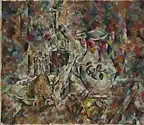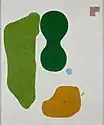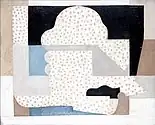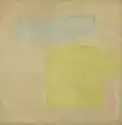Władysław Strzemiński | |
|---|---|
 Strzemiński in 1932 | |
| Born | 21 November 1893 |
| Died | 29 December 1952 (aged 59) |
| Resting place | Old Cemetery, Łódź, Poland |
| Nationality | Polish |
| Known for | Painting, drawing, teaching |
| Movement | Constructivism |
| Spouse | Katarzyna Kobro |

Władysław Strzemiński (Polish pronunciation: [vwaˈdɨswaf ʂt͡ʂɛˈmiɲskʲi]; 21 November 1893 – 26 December 1952) was a Polish painter, art theoretician and pedagogue. He is regarded as a pioneer of Constructivist avant-garde of the 1920s and 1930s and the developer of the theory of unism (Polish: unizm).
Life and work
Strzemiński was born in Minsk to an ethnic Polish family. In 1914, he graduated from the Military School of Civil Engineering. During World War I he served as second lieutenant at the Osowiec Fortress. In 1915, he was severely wounded in the Attack of the Dead Men. In 1920, he married Katarzyna Kobro.[1]
In 1922, he moved to Wilno (now Vilnius), and in the following year supported Vytautas Kairiūkštis in creating the first avant-garde art exhibition in what is now the territory of Lithuania (then under Polish rule).[2]
In November 1923, he moved to Warsaw, where with Henryk Berlewi he founded the constructivist group Blok.
During the 1920s, he formulated his theory of Unism (Unizm in Polish). His paintings inspired the musical compositions of the Polish composer Zygmunt Krauze. He is an author of a revolutionary book titled "The theory of vision". He was co creator of unique avant-garde art collection in Łódź gathered together thanks to the enthusiasm of members of the "a.r." group as Katarzyna Kobro and Henryk Stażewski (the artists) and Julian Przyboś and Jan Brzękowski (the poets).[3]
In postwar Łódź he was an instructor at the Higher School of Plastic Arts and Design Neoplastic Room in Muzeum Sztuki in Łódź, where one of his students was Halina Ołomucki, survivor of the Nazi concentration camps.[4] His Neoplastic Room was installed in the Muzeum Sztuki in Łódź in 1948 but was removed in 1950 as it failed to fit in with the socialist realism aesthetic imposed by Włodzimierz Sokorski, the minister of culture of the Polish United Workers' Party.
His works have been exhibited in such museums around the world as Centre Pompidou,[5] Museo Reina Sofia,[6] Moderna Museet Malmö[7] and Whitechapel Gallery.[8]
In film
He is the subject of Afterimage (2016), the final film by Andrzej Wajda.[9]
Selected paintings
 Still life IV (1926/1927)
Still life IV (1926/1927) Still life (1926)
Still life (1926) Architectural composition I (1926)
Architectural composition I (1926) Synthetic composition I (1923)
Synthetic composition I (1923) Still life 3 (1923)
Still life 3 (1923) Unitist composition 4 (1925)
Unitist composition 4 (1925)
References
- ↑ Ładnowska, Janina (2001). "Katarzyna Kobro: A Sculptor of Space". Artibus et Historiae. 22 (43): 161–185. doi:10.2307/1483659. JSTOR 1483659.
- ↑ Liutkus, Viktoras (2008). "Lithuanian Art and the Avant-Garde of the 1920s Vytautas Kairiūkštis and the New Art Exhibition in Vilnius". Lituanus. 54 (2). Retrieved 5 October 2015.
- ↑ "Afterimages of life. Wladyslaw Strzeminski and rights for art", red: Jaroslaw Lubiak, Paulina Kur-Maj, 2011, Lodz
- ↑ Halina Olomucki, website of the Auschwitz-Birkenau State Museum. Retrieved 3 May 2012
- ↑ "UNE AVANT-GARDE POLONAISE - KATARZYNA KOBRO ET WŁADYSŁAW STRZEMIŃSKI". Retrieved 2018-10-26.
- ↑ "Kobro and Strzemiński. Avant-Garde Prototypes". Retrieved 2018-10-26.
- ↑ "KOBRO & STRZEMIŃSKI NEW ART IN TURBULENT TIMES". Retrieved 2018-10-26.
- ↑ "Adventures of the Black Square: Abstract Art and Society 1915 – 2015". Retrieved 2018-10-26.
- ↑ Harvey, Dennis (21 September 2016). "Film Review: 'Afterimage'". Variety. Variety Media, LLC. Retrieved 10 January 2024.
Bibliography
- Władysław Strzemiński. Readability of Images. Proceedings of the international conference devoted to the work of Władysław Strzemiński, 13–14 October 2011, Muzeum Sztuki, Łódź 2015.
- Władysław Strzemiński 1893–1952. On the 100th Anniversary of His Birth, Muzeum Sztuki w Łodzi, Łódź 1993.